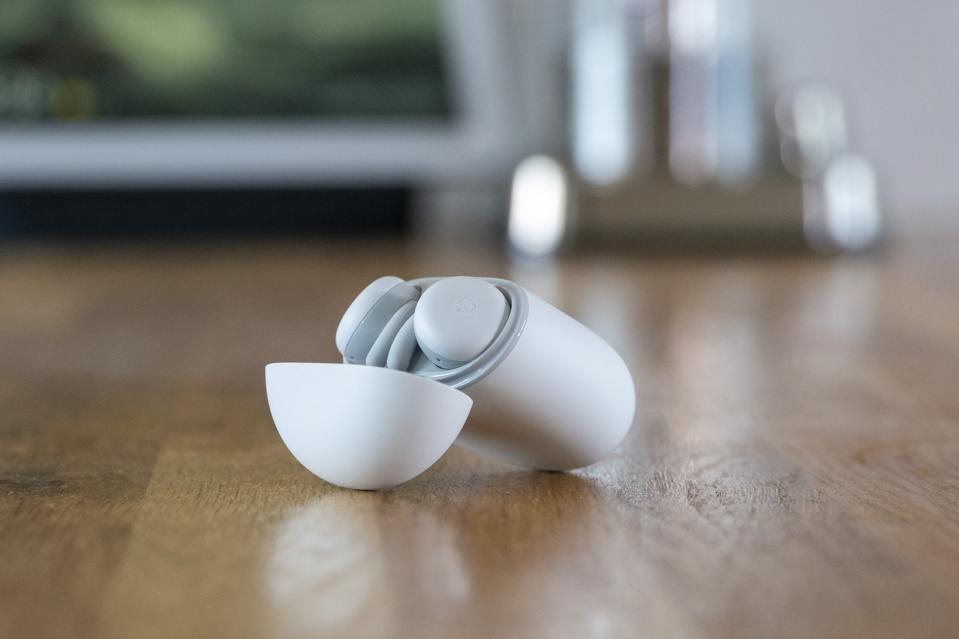The Google Pixel Buds A-Series, in all their fresh glory.
Google is back with a brand-new pair of earbuds called the Pixel Buds A-Series. Launching June 17 in the U.S. and Canada for $99 (pre-order here), they sit in Google's roster as a cheaper alternative to last year's iteration, but having tested them for just under a week, it's clear they're cheap in name only.
Whilst I liked the innovative design and smart features of last year’s pair, the earbuds were blighted by serious connectivity issues. Hundreds of owners complained about persistent audio cut outs that made the buds virtually unusable. They were eventually fixed with updates, but not for all owners. The entire saga left a bitter taste in the mouths of many Pixel Bud buyers.
So how do the new earbuds fare? Better. Much better. Not only does Google’s third attempt at headphones present no obvious issues (yet), there are clear, noticeable improvements. There's also a new low price, $99, that underscores their role as a budget version of the 2020 Pixel Buds. But how much has been scarified to meet that price, and even still, are they worth it?
Google Pixel Buds A-Series: Technical Specifications
Price $99 | Bluetooth 5.0 | Microphones: dual beamforming microphones| Sensors: single IR proximity sensor, capacitive touch sensors | Battery life: 5 hours of listening time and 2.5 hours of talk time. With the case: 24 hours of listening time and 12 hours of talk time | Colors: Clearly White and Dark Olive| Dimensions: 20.7 x 29.3 x 17.5 mm per bud | Weight 5.06g per bud, 52.9g in case
Small and stable
Despite the A-Series being the cheaper version of the flagship Pixel Buds, they look vertically identical. The pill shaped case design (which remains my favorite) returns, as does the nice-to-touch matte texture.
The buds themselves have the same stabliser arc (protruding wing tips) that wedge the buds into your ear too. Opinions about the arc are divided because some found them uncomfortable for long periods of use, but this was never the case for me and still isn’t. I like that Google prioritized the most stable fit possible, which is an often overlooked area of expensive, delicate earbuds that all too easily fall out and break.
Despite the similarities, the stabilizer arc appears to be slightly longer in the new buds, for which I’m thankful. A more solid fit is always better in my book. The A-Series is slightly lighter, though, at 5.06g per bud (versus 5.3g for the 2020 Pixel Buds). The charging case enjoys a similar reduction at 42g (without earbuds) versus 56.1g for last year’s case.
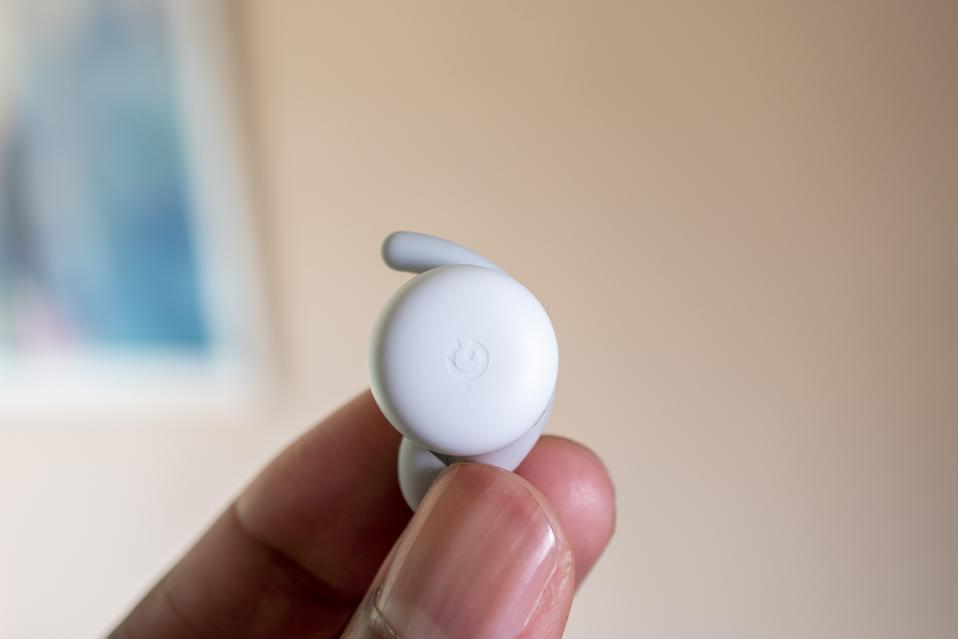
The Pixel Bud A-Series stabilzer arc.
To make that happen Google had to slice some features like Qi wireless charging, one IR proximity sensor for in-ear detection, and the accelerometer and gyroscope. That means there’s no voice accelerometer to detect jaw movement, which is supposed to improve voice quality on a call when you’re in a windy environment. Whilst wireless charging is a reasonably sizeable sacrifice, I can’t say I’ve missed the voice accelerometer or second IR proximity sensor because in-ear detection appears to work just as well.
I also like the miniaturized, anteater-style design. The end of the rubber tips disappear far into your ear canal and you’re not left juggling two heavy protruding earbuds that are barely hanging in there—an issue for more powerful buds like the Jabra Elite 85T.
Despite the smaller design, Google still managed to cram in the same custom 12mm dynamic speaker driver, dual microphones, spatial vents and capacitive touch areas. It’s important to note that there is no active noise cancelling here, so Pixel Bud A-Series owners are at the constant mercy of ambient noise.
The spatial vents make this worse because they are essentially holes that let in more sound. The reason, Google argues, is to alleviate the plugged-in, pressurised, feeling that other buds with tighter fits have. For those who like to have some sensory connection to their immediate surroundings, this is useful. You won't feel like you're underwater, or in my case, have anxiety that I've ignored someone trying to get my attention.
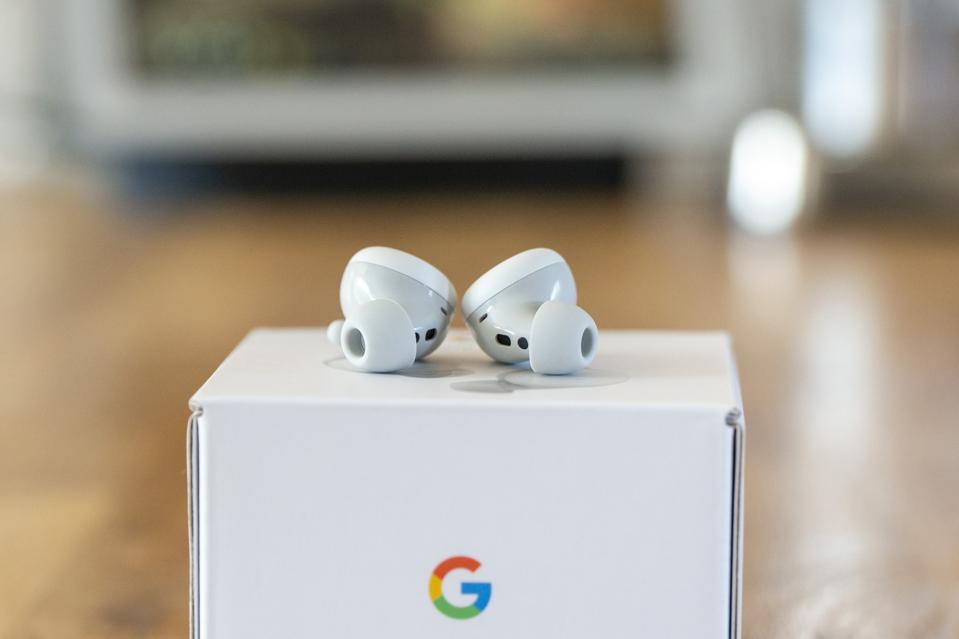
Spatial vents stop the 'plugged in' feeling in the Pixel Buds A-Series.
The downside is that these aren’t particularly useful earbuds in a gym blaring out loud music. They also can’t compete with the piercing screech of a rapidly moving London Underground train. With headphones like the Samsung Galaxy Buds Plus or Samsung Galaxy Buds Pro, they give you an option to digitally pipe-in ambient sound. It’s a useful feature when cycling or waiting for an announcement at a train station. The spatial vents on the Pixel Buds A-Series don't offer this level of ambient noise, so they're not particularly useful in either scenario.
The capacitive area has greatly improved, though. I was scared to touch the 2017 Pixel Buds for fear of accidental commands. This improved in the 2020 Pixel Buds and the A-Series appears to have finally nailed it. They are responsive and accurate. Skipping tracks with a double tap or answering a call executes every time I try.
It sounds like a simple and obvious thing to get right, but the capacitive area can cause issues for earbud makers. Samsung’s Galaxy Buds Pro require a few aggressive taps to register a touch, and Google’s past efforts have been overly sensitive. I feel confident using gestures to control content with the Pixel Buds A-Series in a way I don’t with others.
Affordable, but not cheap sounding
With minimal passive noise cancellation and no active noise cancellation, the Pixel Buds are severely restricted when it comes to where they can be used. My eardrums are not a fan of turning up the volume to drown out competing noises, so loud environments will win against these buds.
But in the right place, the Pixel Buds sound good, especially for $99. They produce a balanced sound with clear lows, mids and highs. I can clearly distinguish between different instruments and elements in Dua Lipa’s Break My Heart, with Dua’s voice coming through clearly amongst the busy elements. I like that they produce a balanced, clear sound that don’t prioritise one frequency over another and that I can hear individual instruments in a track.
But they are missing the richness of a more accomplished pair of buds like Samsung’s Galaxy Buds Pro, which have a fuller and more dynamic sound that’s instantly clear when swapping between the two. Tracks like Yuuuu by Busta Rhymes, or Smoke N Grams by Jayy Grams, come to life and sound more energised on Samsung’s buds, but sound quite a bit flatter on the Pixel Buds. The bass boost feature in the Pixel Buds app (or Bluetooth settings menu if you’re using a Pixel phone) adds extra punch. The additional bass doesn’t sound as well executed as some pricier buds, but it also doesn’t have the distorting effects of a cheap Bluetooth speaker.
What’s missing is deeper equaliser settings that let you tweak the sound to your tastes. It looks like Google has specifically worked on perfecting a certain audio experience, which is why there’s still no equaliser settings or sound profiles. That fits with Google’s ‘we’ll do it for you’ attitude, but some customisation would be welcome. Outside of this, the buds sound good. I like them. Especially at $99.
AI infused
The Pixel Buds are imbued with Google’s AI smarts, which give them extra abilities that are not available on any other headphones. Conceptually my favourite is the language translation feature, which beams translated conversation into your ears via the Pixel Buds and then does the reverse out of your phone’s speakers.
I have only been able to try it with YouTube videos because of lockdown, but it is undoubtedly fun to use. The Pixel Buds’ role in this exchange is fairly slim; they simply replay translations into your ears rather than out of the phone's speakers, but you can initiate a conversation by saying “OK Google, help me speak Spanish”, which will launch the Translate app. It’s all relatively seamless (with the caveat of not having tried with an actual person) and I’m excited to see where this technology ends up.
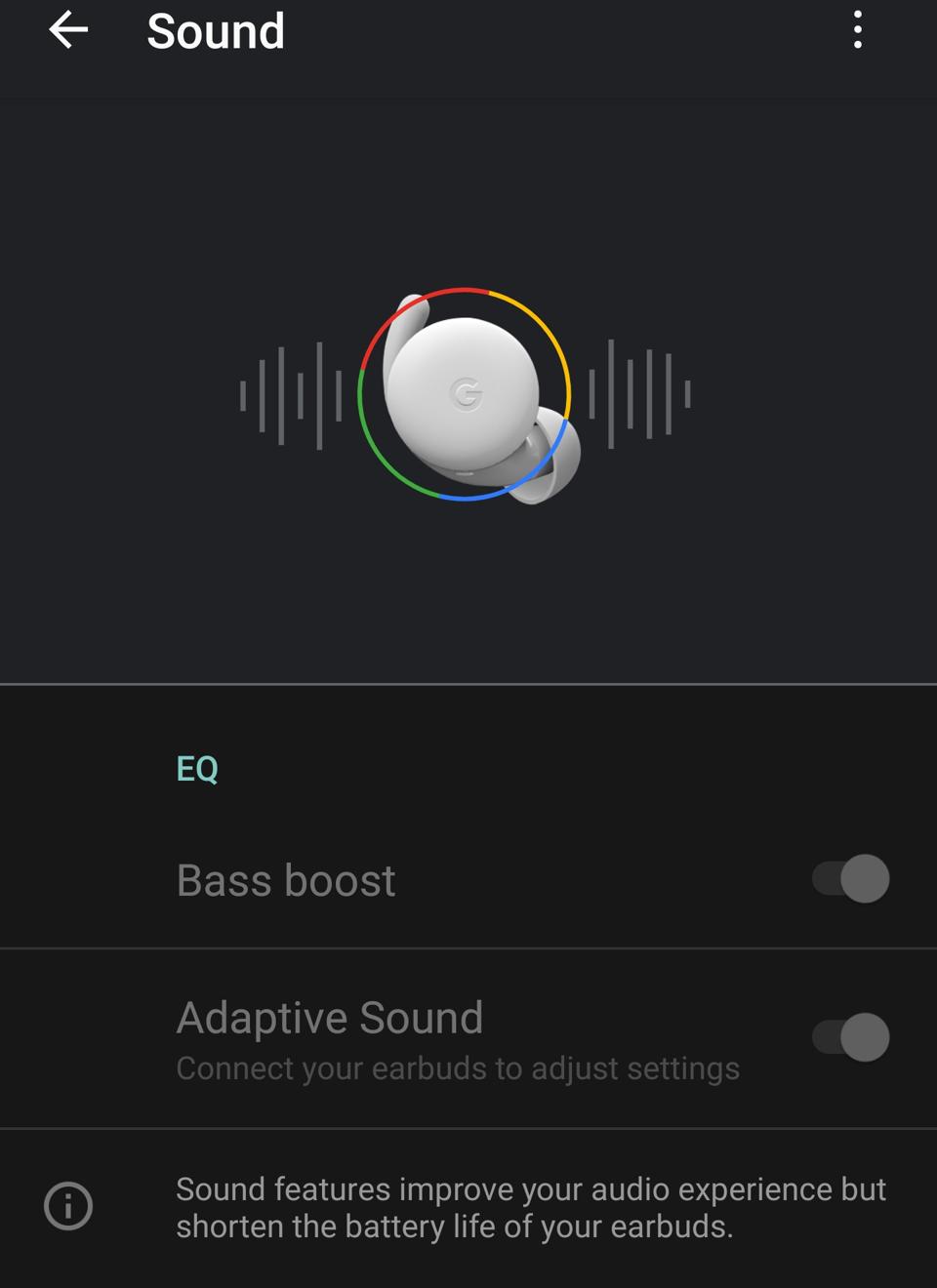
The Pixel Buds A-Series has unique AI-powered features.
There’s also adaptive sound, which automatically adjusts volume depending on your environment. I wasn’t sure about letting Google handle my very specific volume preferences, and I was right to be skeptical. Volume levels sharply jump in response to sudden noises, which is jarring. In the gym, people talking loudly or the sound of clattering weights abruptly sent the volume upwards to a level that wasn’t comfortable for me. It then quickly climbed back down once the intruding sound stopped. It’s a clever idea, like much of what Google does, but also like much of Google’s end product, the execution is lacking.
What’s not clear is the status of future feature drops—Google's semi-regular feature update program for its hardware. The 2020 Pixel Buds got a huge feature drop in August, but they haven’t received anything since. Pixel phones receive one every three months, but the Pixel Buds only received one drop 10 months ago, which bought in new features like sharing detection and bass boost. Google didn’t immediately respond when asked if the Pixel Buds A-Series will also get feature drops. I'll update this review if it does.
Update 3/6 17:54: Google tells me it has no feature drop plans for the Pixel Buds.
A better connection
The good news is that I am yet to experience any audio cut outs on the Pixel Buds A-Series. You may remember that last year’s earbuds received hundreds of complaints from frustrated owners who were experiencing persistent audio interference. It was a serious enough problem that Target offered refunds to affected users and Google released updates to solve it. The new buds, however, do not appear to have the same issue. I’ve only had them for just under a week, so further testing and a mass launch may prove otherwise, but for now they are performing well.
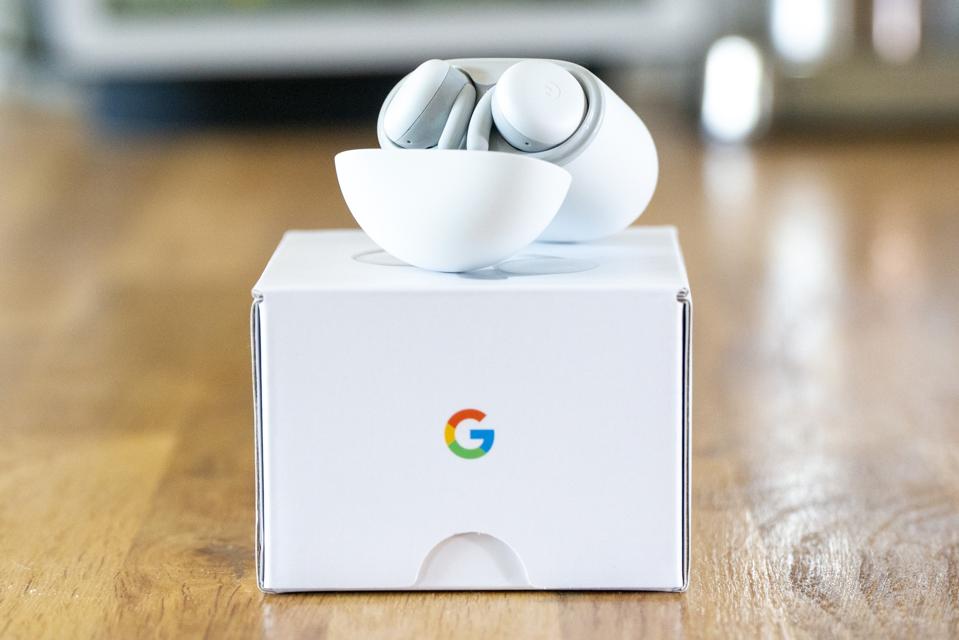
The Pixel Buds A-Series have middling battery life.
Battery life remains unchanged from the previous iteration. The Pixel Buds A-Series offer up to five hours of listening time, or up to 2.5 hours of talk time. This is extended with the case, with up to 24 hours of listening time, or up to 12 hours of talk time.
This is roughly the same as Apple’s AirPods (5 hours) and quite a bit less than Samsung’s Galaxy Buds Plus (11 hours) and Galaxy Buds Pro (9 hours). I personally haven’t ever used earbuds or over-ear headphones for a straight five hours apart from on a flight, so I rarely exceed the maximum listening time. And since they charge in the case, I haven't been left lacking.
Are the Google Pixel Buds A-Series worth your money?
I’m quietly impressed by Google’s latest Pixel Buds. No, they don’t have the best sound or the longest battery life. But they do sound good and they’re designed with ergonomics in mind. I like that Google’s Pixel Buds A-Series is essentially budget version of last year’s earbuds save for a couple of features you likely won’t miss.
The A-Series feels like the search company wiping the slate clean and having another go at an originally promising—but ultimately flawed—pair of smart earbuds. I can comfortably say the slate is near spotless and Google has created a well-executed pair of earbuds that largely deliver on their promise. At this price, they’re hard to ignore for casual users. Pre-order yours today for $99. They ship June 17.
